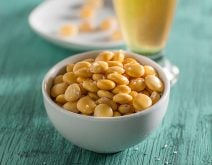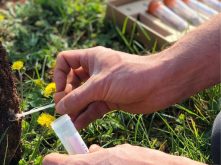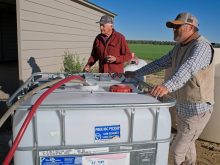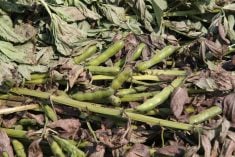There aren’t too many western Canadian farmers who would consider growing a pulse crop without first applying rhizobium bacteria to the seed to help the plant roots fix nitrogen in the soil. The benefits of that technology are well proven and accepted.
But what about a foliar application of bacteria to the leaves and stems of grain and oilseed crops to help those plants capture nitrogen from the atmosphere? It’s roughly a $15-per-acre treatment that can potentially increase yield and perhaps one day allow farmers to reduce the amount of added nitrogen. There were a couple of new products on the market in 2021 making a claim for increased yield, but do they work?
Well that question opens a wide-ranging discussion among product developers, farmers, agrologists and soil fertility specialists across Western Canada.
Read Also

Claas brings 1000 Series SP forage harvesters to Canada
In mid-August, Claas unveiled its new line of Jaguar forage harvesters at an event in Visalia, California, deep in the heart of that state’s dairy region.
Two companies selling the biological products say they have some pretty solid research showing the treatment does produce quite consistent and profitable benefits.
Azotic North America, with Canadian headquarters in Guelph, Ont., introduced its Envita biological over the past couple of years. The product has a track record for improving corn and soybean yields in the United States as well as Ontario and Quebec. Now available for use in Western Canada with canola and cereal crops, the company even offers a product replacement guarantee if farmers don’t see a yield improvement that at least covers their product costs. The NexusBioAg team of specialists is handling marketing and distribution of Envita in Western Canada.
And Corteva Agriscience last year introduced Utrisha N, also a foliar-applied biostimulant for canola and wheat with research that shows at least an average one-bushel yield increase. And about 70 per cent of the time even a 2.2-bushel yield increase.
With crop prices of $14 to $15 per bushel of wheat and $25 per bushel of canola, a one- or two-bushel yield increase should more than cover the treatment cost.
Looking at a few on-farm trials in 2021, some producers who applied the biostimulants say it appears the treatment did add those few more bushels to their canola yields, which at current prices is worth a lot.
While, on the other hand, a couple of other producers say they saw no benefits in their field-scale trials using the products on barley and canola. One farmer says the yield on his malt barley crop was actually two bushels lower comparing the treated with the untreated.

And as agrologists and soil fertility specialists weigh in on the topic, there is lots of “hope” that this technology works, but these observers feel there needs to be more independent, third-party evaluation of these biological treatments. Do they work, and under what conditions, and with what consistency?
The great hope is, though, if all the dots do connect, it will be a great economical tool for farmers to increase yields. Also, if the treatment allows producers to cut back on soil-applied nitrogen by even a few percentage points that’s a considerable savings, and reduced nitrogen could also mean a huge reduction in agriculture’s carbon footprint — several check marks in the win-win-win column.
The take-home message
The concept of biologicals capturing nitrogen from the atmosphere has great potential, so don’t dismiss the products out of hand. Ask to see relevant research based on western Canadian growing conditions. But until there is more independent research, perhaps start out with proper on-farm trials treating 50, 100 or 200 acres to see how the products perform on your farm. And stay tuned for future research results.
About the products — Envita
Nolan Berg, president of Azotic North America, says the company’s research shows quite consistent yield increases as Envita is applied to a range of crops such as corn and soybeans in the United States along with canola and cereals in Western Canada.
Applied as a foliar spray, Envita bacteria naturally metabolize nitrogen directly from the air, allowing growers to maintain their nitrogen fertility program and increase yields. It is described as a naturally occurring bacterium called Gluconacetobacter diazotrophicus (Gd), which forms a symbiotic relationship with the host plant and provides nitrogen to every cell in the plant, both above and below ground, throughout the growing season.

“It is probably one of the most consistent biologicals out there,” says Berg. “We know that more than 80 per cent of the time it is producing a yield response. That’s why we can offer a performance guarantee that the product should at least pay for itself.”
Berg says while 2021 was an exceptionally dry year and several of their research trials just fizzled due to drought and heat, they also had reports from farmers showing at least two-bushel yield increases in canola and up to four- and five-bushel yield increases in wheat, even under dry growing conditions.
He says some farmers are planning to use Envita as somewhat of an insurance program. They will apply the usual soil fertility program for the crop and apply Envita in crop. If growing conditions get dry to the point where there is little nutrient uptake through the roots, then at least Envita is working within plant cells to capture nitrogen from the atmosphere.
And from Corteva Agriscience
Introduced later in 2021, Corteva Agriscience will be rolling out its Utrisha N naturally derived nitrogen-fixing bacterium to Prairie farmers for the 2022 growing season.
Kirsten Ratzlaff, product manager for seed-applied technology, fungicides and nutrient management for Corteva Agriscience, says Utrisha N was trialled at about 200 sites across Canada last year.

“It’s been quite a rigorous testing process to ensure that Utrisha N is going to provide the value we intend to provide our Canadian growers,” Ratzlaff says.
“We are really pleased with what we’ve seen performance-wise so far. We will be continuing with our research trials in 2022.”
Results from 2021 field trials showed on average canola crops treated with Utrisha N had a 1.3-bushels-per-acre yield increase, and 69 per cent of the time treated crops produced a 2.2-bushels-per-acre yield increase or more. There were very similar results with spring wheat and durum wheat trials.
Utrisha N, based on the natural bacterium, Methylobacterium symbioticum, is applied as a foliar application. The bacteria enter the stomata openings on the epidermis of leaves and other plant material and colonize the cells within them. The bacteria then quickly begin to capture nitrogen from the air and convert it into a usable form for the plant.
Ratzlaff recommends farmers pay attention to a few details when applying Utrisha N to optimize its performance:
- Apply earlier in the day when plant stomata are most likely to be open.
- Apply within the recommended temperature range of between 15 and 25 C. If temperatures are 25 C or higher the stomata will be closed.
- The product can be applied with a number of herbicide and fungicide tank mixes, but double-check that products are compatible.
- Ensure proper coverage, use a good, clean water source and apply the product at the 10-gallon-per-acre water rate.

The farmer experience
Four Prairie farmers trialling the Envita product in 2021 ended the season with a split decision.
Kerry Horkoff and Larry Kalmakoff, who farm in the Kamsack/Canora area of east-central Saskatchewan, say they saw no yield improvement from the application of the nitrogen-fixing biological product. While Jason Beck of Cluny, Alta., and Malcolm Chisholm of Turtleford, Sask., say their on-farm trials did produce yield increases from field-scale plots treated with Envita.
Horkoff set up an on-farm trial on a field of CDC Fraser malt barley. He flagged two 90-foot-wide sprayer strips of untreated barley and applied Envita to the rest of the field at the proper herbicide timing. He also treated a field of InVigor canola with Envita as well.
Come harvest, the barley was swathed. At combining, he collected barley from the untreated or check-strip areas, and in separate combine passes he collected barley from the treated area. He took both batches of barley to the Viterra elevator at Kamsack for weighing.
“The final weight showed the yield on the treated barley was actually two bushels lower than the yield on the untreated barley,” says Horkoff. “It cost me about $20 per acre to buy and apply this product with my own sprayer, so I was really disappointed.” Discouraged by the on-farm barley trial, Horkoff says he didn’t bother to take canola samples for weighing. He says with a standard yield monitor on a combine it is difficult to measure a two-bushel yield difference.
Kalmakoff set up side-by-side treated and untreated check strips in a 160-acre hard red spring wheat field as well as an 80-acre LibertyLink canola field. He applied the Envita product to crops at fungicide timing.
“It was a very dry growing season and I didn’t have a weigh wagon available,” he says. “But for me, there was no visual difference between the treated and untreated strips of treated and untreated crop.” He didn’t attempt to measure any yield differences.
Now quite skeptical of product claims for yield increases, Kalmakoff and Horkoff say the treatment might work on corn or soybeans or vegetable crops, but they don’t see it having a fit with grain and canola crops.
“I think we need to see a lot more independent, third-party research and evaluation before we’ll know if these products work,” says Horkoff.
Beck, who farms at Cluny about one hour east of Calgary, did a trial with Envita involving about 120 acres of Nexera canola grown under irrigation.
Beck applied the usual fertility to the whole field, which includes about 530 pounds per acre of a 32-11-2-7 fertilizer blend. About mid-July at the 20 to 30 per cent flower stage he applied Envita to about 118 acres of the canola and left a two-acre check strip of untreated crop.
At harvest, his combine yield monitor showed an average three-bushel yield increase on the Envita-treated canola compared with the untreated canola.
“I was impressed with the results,” says Beck. “At $22-per-bushel canola that product paid for itself about several times over.” He figures it cost him about $11 per acre for the Envita treatment. This coming growing season he plans to try Envita on irrigated malt barley. He might try it on dryland crops if it looks like there might be normal precipitation, but he’d be leery to apply it to dryland crops if conditions were extremely dry.
In northwest Saskatchewan, Chisholm was really impressed with a six-bushel yield increase from Envita-treated canola compared with untreated canola. While it was a drier growing season in an area that usually gets decent precipitation, Chisholm couldn’t think of any other factors to credit for the yield increase.
Working with a 170-acre field, Chisholm applied the usual fertility through a variable-rate prescription to the whole field seeded to an InVigor canola. He selected a 40-acre parcel in the middle of the field to be treated with Envita applied during the second herbicide timing in late June. The remaining 130 acres were left as the untreated check area.
“There wasn’t a huge visual difference over the 170 acres early on, but then at flowering I noticed the 40-acre parcel looked a bit more vigorous than the rest of the field,” says Chisholm. “But then harvest really told the story.”
His agronomist brought in a weigh wagon to get an accurate yield measure on the treated versus untreated areas. The Envita-treated 40 acres yielded an average of six more bushels compared with the untreated area of the field.
“That field even had a bit of hail, and the growing season was quite dry, so it appears that product made a difference,” he says. “And with canola prices these days, it is nice to get as much yield as you can.”
Chisholm says he will probably try Envita again in 2022, perhaps on wheat this time.
From an agronomy perspective
A sampling of western Canadian agronomists and a soil fertility specialist say the concept of using naturally occurring bacteria on crops to help plants capture nitrogen from the atmosphere has a lot of promise indeed, but more independent research is needed.

John Heard, a soil fertility specialist with Manitoba Agriculture, says the Envita and Utrisha N developers have “compelling split field demonstration results indicating a likelihood of higher yields with their products,” but he would still like to see third-party, unbiased evaluations before making any recommendations.
Heard admits he did a pretty simple evaluation of the two products on small plots of spring wheat, canola, soybeans and corn last year and essentially saw no yield advantage. Heard says he doesn’t have the resources to set up proper replicated research trials, but he is hoping some independent agency takes on the pro-ject.
He’s also a bit concerned that these biological products are being positioned to use along with a regular crop fertility program. He’d like to see if one day farmers would be able to cut back the amount of applied nitrogen and use the biologicals to top up the nutrient requirements of the crop.
“The concept has great promise,” says Heard. “But we need the equivalent of the Nebraska Tractor Test to make unbiased, third-party research into how these products might be used.”

Agronomist Jason Voogt, owner of Field 2 Field Agronomy, based in Miami, Man., has a similar message. He believes the concept of the biologicals is good in theory but right now there is “too much inconsistency in results,” he says.
Voogt did some preliminary work with Corteva last year involving farm clients trying Utrisha N in simple side-by-side comparisons of treated and untreated acres of spring wheat and soybeans. They saw no response from the treatment but he notes the trials were not replicated.
“There are a number of questions that need to be answered,” he says. “Will these products work under all types of growing conditions? Even bacteria need some amount of moisture to function. Also, will these biologicals work on every crop, or are there some that are more responsive?
“Right now, I believe we are at Phase 1, just the early stages of understanding how these products might work,” says Voogt. “Much more research is needed before we have the answers.”

And that’s the direction agronomist Matt Gosling, owner of Premium Ag Services based in Strathmore, Alta., just east of Calgary, is planning to take in evaluating nitrogen-fixing biologicals in 2022. The research division of his company plans to set up proper, independent research trials this growing season to see if, where and when these products work.
“The concept is great,” says Gosling. “Can these products deliver consistent results? Can they be used to replace 15 or 50 pounds of nitrogen fertilizer? There are some important questions that need to be answered.”
Gosling says Premium Ag plans to set up replicated trials with both the Envita and Utrisha N products, along with untreated check strips. The project will look at how well the products work on different crops under different growing conditions. He also plans to have trials using a UAN dribble band applied as a top-up fertilizer in season. Among the questions field trials might answer — can the biological treatments be used to produce enough nitrogen to replace a UAN top-dress application?
















